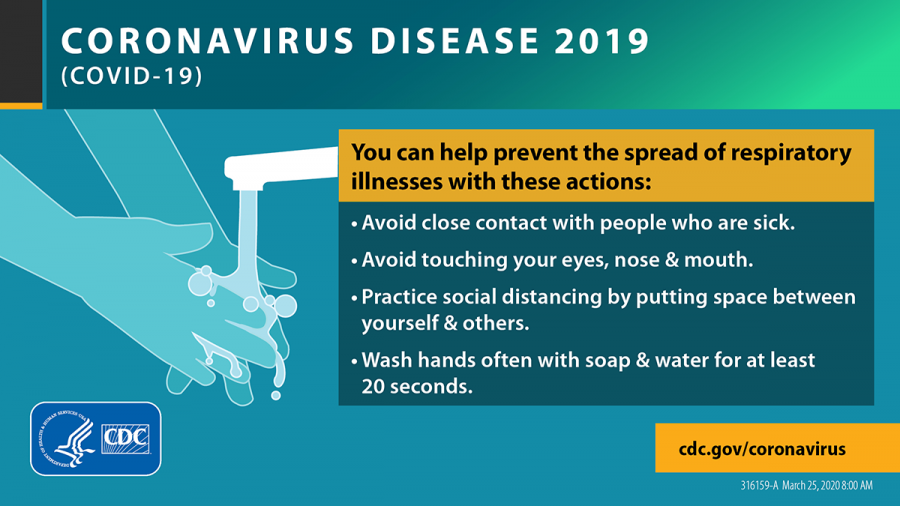Ready Or Not, Here We Come: Majority Of West Students Return To Campus On Split Days
Centers for Disease Control and Prevention
Graphic released by the CDC (Centers for Disease Control and Prevention).
October 26, 2020
After more than six months away, Belleville West Mighty Maroons once again populate the hallways and fill the building with the sounds of laughter, conversation, and slamming lockers. On September 17, District 201 decided that current St. Clair County COVID-19 health metrics were such that it was safe to return to blended in-person learning, but some question the decision.
From one-way staircases and directional markers on hallway floors, to spaced out desks and reminders to stay 6 feet apart, our school experience is going to be dramatically different.
Some of our usual classmates, teachers, and friends won’t be in our classrooms this year. Whether they ended up in the other group of students on alternate days or their families decided that the risks didn’t outweigh the rewards, this school year is going to be far from normal.
Did District 201 make the right call? It depends on who you ask. Even students likely won’t be able to reach a consensus, and parents are equally as split on the decision.
The quality of our education is tantamount to almost any other aspect of our high school experience. Soon many of us will be off to college, and our teachers are tasked with making sure that we are up to the challenges we will face as we take the next steps in our continuing education. So the question becomes “Is remote learning as effective as traditional in-person learning?”
In a study conducted by Georgia College and State University, using students in a macroeconomics class, J.J. Arias, Jon Swinton, and Kay Anderson concluded that “the face-to-face class performed statistically, significantly better than the online class” This makes sense because of both the subject matter and the ability to interact with the instructor face-to-face and receive immediate clarification or further instruction.
What the study fails to take into account is that, while macroeconomics may not be an ideal course to take remotely, even the United States Department of Education states: “Used to support both teaching and learning, technology infuses classrooms with digital learning tools, such as computers and handheld devices; expands course offerings, experiences, and learning materials; supports learning 24 hours a day, 7 days a week; builds 21st century skills; increases student engagement and motivation; and accelerates learning.”
Many teachers require students to give speeches or presentations that can be challenging to do remotely. This becomes especially difficult when presenting with props or trying to demonstrate a trade or science lab procedure. It’s hard to weld from home or mix different chemical compounds in your living room, dining room, or bedroom.
But in the modern workforce, a place many teachers and parents alike refer to as “the real world,” technological skills are increasingly important in order to stay productive and competitive. Whether it’s networking with satellite offices in different time zones or different countries, video conferencing and other digital presentations allow teams to collaborate when geography or time constraints prevent in person meetings.
Further adding to the advantages of in person learning is the lack of resources that would enable all students to participate in online learning.
Not all homes are able to offer high speed internet or dedicated computers and printers to help facilitate students learning from home. A July 2019 study by the NPD group found that “31 percent of U.S. households do not currently have a broadband connection.” The lack of a reliable internet connection capable of streaming videos or connecting students to video conferences with their teacher and fellow classmates is a huge hurdle to overcome.
Yet, District 201 has been able to offer a lifeline to our classmates who are unable to connect with their teachers, classmates, and digital classmates due to a lack of internet services at home. Since March, school buses have been strategically placed around the community, rotating days and places, with hot-spot connections allowing students to connect and complete assignments, attend video conferences, and email their teachers with questions.
Adding to the challenges of remote learning are those students who need specialized education due to physical or mental abilities that may be different than those of students in the general population. Specialized learning plans are individualized to meet the needs of each student and can often lose momentum in the remote learning environment. The law known as the Individuals with Disabilities Education Act, or IDEA, provides federal funding for things like OT, PT, speech lessons, and life skill classes that are almost impossible to provide in a remote learning environment.
Unfortunately for this portion of the student body, there is no easy answer. The uniqueness of each student’s Individualized Education Plan (IEP) is often such that these differently abled classmates require face-to-face assistance and guidance. But it bears keeping in mind that these students may also have underlying medical conditions that make them more susceptible to viruses like the novel coronavirus.
Equally important to consider is the fact that our schools have become a “safety net” for those who face food shortages, physical, sexual, or verbal abuse, and unstable home environments. Teachers and other school staff members are “mandated reporters” as defined by the Abused and Neglected Child Reporting Act and often sit on the frontlines in advocating for students stuck in horrific situations.
Yet, there are some who would argue that to subject more than 2,000 underaged students, and ultimately their families, to a highly contagious virus that is responsible for a worldwide pandemic in itself borders on neglect.
Even the Centers For Disease Control (CDC), in a now retracted statement, admits that COVID-19 is highly contagious and easily spread. “There is growing evidence that droplets and airborne particles can remain suspended in the air and be breathed in by others, and travel distances beyond 6 feet (for example, during choir practice, in restaurants, or in fitness classes). In general, indoor environments without good ventilation increase this risk.”
With only half of the student body in attendance each day, hallways and stairwells are still going to be crowded. Desks in some classrooms may not allow students to remain six feet apart. Choir classes are going to be outside, weather permitting, and Physical Education classes no longer allow students to dress out, but will still require participation. If breathing, singing, and participating in an athletic activity are recognized to be risky, and hallways and stairwells are going to be crowded at best, why would we think that we aren’t setting ourselves up to become statistics?
Is a return to in-person learning the best possible decision for the future of Maroons?
Does any of this justify risking the health of over 2,000 Belleville West students, faculty, administration, and support staff, to say nothing of those they share their homes with or the community in which they live?
To put it in simple terms, only time will tell.


